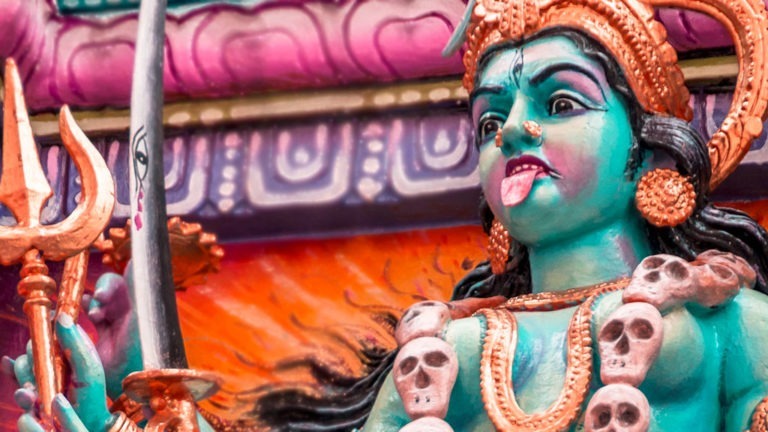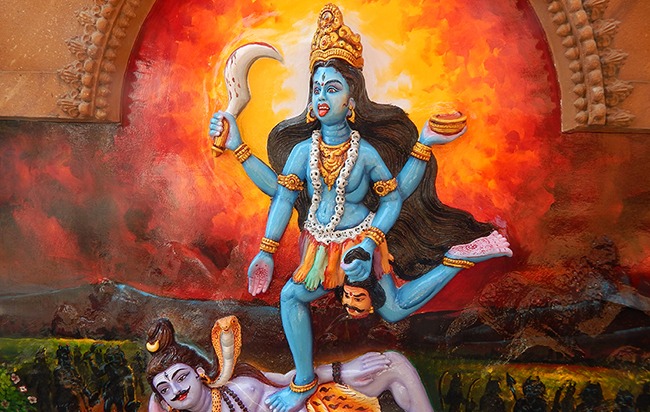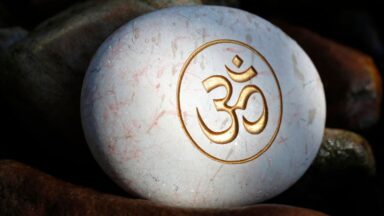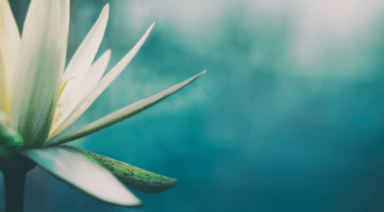Creating the Container for Kali: How the Goddess Shows Up in Your Life

When I found her, Kali was waiting in the window of the Ma Shrine (a temple for female deities) at my new ashram home. I was mesmerized. She didn’t look anything like the other goddesses in the temple which was filled with examples of the feminine divine. All the other goddesses were wooden or metal, seated on a lotus or astride a peaceful looking mount. Even Durga carrying all her weapons and emanating powerful assurances sat calmly atop her tamed tiger.
In contrast, Kali was a smaller wooden statue painted in the brightest colors of the room. With jet black skin and the reddest tongue extended through her open mouth, reaching for me as if to swallow me whole, she wore a necklace of severed heads and a skirt of severed limbs.
She stood atop a resigned Shiva Lord of the Universe as a conqueror claims their prize. There was nothing peaceful about her! She was ferocious, and everything about her image should have been terrifying in my context of non-understanding. But I wasn’t afraid. I was drawn to her.
Kali was the first goddess I would ever have a relatable experience with from energetic understandings that lay beyond the perception of her form. I sat there and looked to her for what seemed like hours. Every day I would go to the Ma Shrine after our morning meditations and visit all the mother goddesses, offering Kali a flower and trying to feel what she was awakening in me: my power.
Years later, I became a mother myself. The day I became a mom, was the most beautiful experience of celebrating life and specifically that of my son, who is my everything. He is a constant source of inspiration for me still, just six and a half years along my journey into becoming a mother goddess. Love like this has no description you can place from pen to paper.
Asana Practices For Connecting With Kali
Kali is strength and perseverance. In asana practice, anytime you feel you just can’t hold a pose for one more breath or flow through a challenging sequence one more time you can visualize and feel her power flowing through you. Warrior poses, goddess pose, and lion’s breath can all be reminders of that inner resource that is our personal connection to Kali.
The ultimate experience of Kali on the mat happens at the end. When we roll from the pose of death, savasana, into the fetal position awaiting our rebirth. It’s Kali’s strength that frees us from what we have left behind on the mat. It’s Kali’s light that shines on the path forward.
Meditations on Kali
In meditation, we can cultivate the qualities we experience focusing on the representations of divinity and draw strength from their power. Meditating on Kali we remind ourselves that, “today I am strong.” I am the Ma. I can devour any darkness no matter how heavy and hard it may seem and bask in the light.
- Find an image or a statue of Kali that resonates with you. Remember, feeling a connection internally to her image doesn’t have to mean you understand it cognitively. You may also find her a little scary at first, but it’s exactly that journey through fear that she teaches us.
- Sit calmly in a quiet space and gaze at the image of Kali feeling the place in you that is harmonizing with her energy. From time to time, offer her a candle, a flower, some incense, or a sweet treat to develop a relationship with the goddess.
- Use Kali’s mantra to resonate on the same frequency as her power and feel your own inner resources grow strong. If you like, you can use a mala or prayer beads to say the mantras 108 times: Om krim kalikayai namah.
Flowing Through the Throat Chakra with Saraswati

A while back I finally had my Vedic astrology chart done and was informed I had the goddess Saraswati in my chart as well as the lord Hanuman. I love to sing and chant in my classes and lead Kirtan, so this all made sense to me because Hanuman loves to fly and was known for his love of singing. Meanwhile, Saraswati rules the throat chakra and is the goddess of music, clear speech, knowledge, and communication—things I’m always striving towards.
Leading a retreat in Bali, I had been drawn to statues and images of Saraswati and brought some home. I realized that my own need to balance my throat chakra through chanting was an aspect of Saraswati in me. And if you’re ever in need of speaking your truth or communicating more clearly, invoking the essence of Saraswati can be very helpful.
Saraswati and the Sound of Om
At the beginning of everything, when the Universe was a swirling mass of nothing and everything, Brahma stood staring at the chaos. Brahma, of the Holy Trinity of Brahma, Vishnu, and Shiva, was well-known as the Creator and representative of brighter, new beginnings. He stood scratching one of his four heads in confusion. He wasn’t sure how to get started with his task of creating something of a Universe out of a gurgling, swirling, bubbling mass of chaotic energy. Saraswati, who was Brahma’s wife at the time, saw Brahma’s confusion, so she decided to help in her own way.
Brahma heard the sound of a great rushing cascade of water, but looked around and saw nothing. It was from the depths of his being where the water moved and flowed through his throat. A great waterfall poured out of his mouth, and with the waterfall came Saraswati.
She was fascinating and beautiful to behold. Her skin as luminous as the moonlight, her hair as black as night with no moon. She held a stringed instrument in her arms and began playing. And with her music, she spoke. She told Brahma she would give him one sound, which he was to use to create order from chaos. The sound held three syllables: A, U, and M.






































